Cheek reconstruction: current concepts in managing facial soft tissue loss
- PMID: 20567705
- PMCID: PMC2884872
- DOI: 10.1055/s-0028-1095888
Cheek reconstruction: current concepts in managing facial soft tissue loss
Abstract
Significant defects of the cheek present a reconstructive challenge due to their extremely visible site, as well as limited local tissue supply. In addition, the cheek abuts several structures of expressive function, such as the eye, mouth, and local facial musculature. To achieve satisfactory functional and aesthetic results, reconstruction of such defects requires careful three-dimensional restoration of all missing components, adequate texture matching, as well as functional restoration. Aesthetic reconstruction of facial defects should adhere to the priority goals of first preserving function and second achieving cosmesis. According to the size of the defect, location on the cheek, relationship to adjacent structures, available donor tissue, and existing skin tension lines, a host of techniques is available for closure. As a well-established principle in facial reconstructive surgery, one should use local tissue whenever possible to provide the best tissue for color and contour restoration. However, thoughtful reliance upon the "reconstructive ladder," including direct closure, skin grafting, local flap creation, regional flap placement, and free-flap repair, will invariably guide the surgeon in an optimal approach to cheek reconstruction.
Keywords: Considerations for cheek reconstruction; flap placement; free-flap repair; free-tissue transfer; skin grafting.
Figures
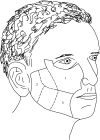
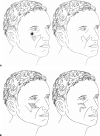




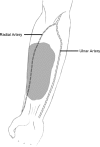

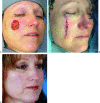
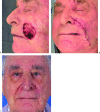
Similar articles
-
Multi-flap Cheek Reconstruction: Merging Triple Advancement, Island Pedicle, and Rotation Flaps for Optimal Aesthetic and Functional Outcomes After Mohs Micrographic Surgery.Cureus. 2024 Oct 22;16(10):e72139. doi: 10.7759/cureus.72139. eCollection 2024 Oct. Cureus. 2024. PMID: 39575024 Free PMC article.
-
The role of soft tissue reconstruction after melanoma resection in the head and neck.Head Neck. 2001 Jan;23(1):8-15. Head Neck. 2001. PMID: 11150065
-
Reconstructive Options for Basal Cell Carcinoma Defects in the Head and Neck Region: An Institutional Experience.Indian J Otolaryngol Head Neck Surg. 2024 Feb;76(1):329-335. doi: 10.1007/s12070-023-04158-6. Epub 2023 Aug 30. Indian J Otolaryngol Head Neck Surg. 2024. PMID: 38440421 Free PMC article.
-
Reconstruction of Cheek Defects Secondary to Mohs Microsurgery or Wide Local Excision.Facial Plast Surg Clin North Am. 2017 Aug;25(3):443-461. doi: 10.1016/j.fsc.2017.03.013. Facial Plast Surg Clin North Am. 2017. PMID: 28676168 Review.
-
Keystone design perforator island flap in facial defect reconstruction.World J Clin Cases. 2020 May 26;8(10):1832-1847. doi: 10.12998/wjcc.v8.i10.1832. World J Clin Cases. 2020. PMID: 32518773 Free PMC article. Review.
Cited by
-
Biofabrication of thick vascularized neo-pedicle flaps for reconstructive surgery.Transl Res. 2019 Sep;211:84-122. doi: 10.1016/j.trsl.2019.05.003. Epub 2019 May 21. Transl Res. 2019. PMID: 31170376 Free PMC article. Review.
-
'Expansion in-situ' concept as a new technique for expanding skin and soft tissue.Exp Ther Med. 2013 Nov;6(5):1295-1299. doi: 10.3892/etm.2013.1269. Epub 2013 Aug 22. Exp Ther Med. 2013. PMID: 24223661 Free PMC article.
-
Outcome in Patients with Partial and Full-Thickness Cheek Defects following Free Flap Reconstruction-A Multicentric Analysis of 47 Cases.J Clin Med. 2020 Jun 4;9(6):1740. doi: 10.3390/jcm9061740. J Clin Med. 2020. PMID: 32512827 Free PMC article.
-
Reconstruction of cheek defects.Eplasty. 2011;11:ic11. Epub 2011 Jun 24. Eplasty. 2011. PMID: 21738829 Free PMC article. No abstract available.
-
Modified Cervicofacial Flap for Large Cheek Defect Reconstruction under Local Anesthesia.Case Rep Surg. 2019 Apr 4;2019:1960609. doi: 10.1155/2019/1960609. eCollection 2019. Case Rep Surg. 2019. PMID: 31093410 Free PMC article.
References
-
- Millard D R. Principlization of Plastic Surgery. Boston, MA: Little, Brown; 1986.
-
- Choi J O, Choi G, Chae S W, Jung K Y. Combined use of pectoralis major myocutaneous and free radial forearm flaps for reconstruction of through and through defects from excision of head and neck cancers. J Otolaryngol. 1999;28:332–336. - PubMed
-
- Kavarana N M. Use of a folded forehead flap for reconstruction after a large excision of the full-thickness of the cheek. Plast Reconstr Surg. 1975;56:629–636. - PubMed
-
- Baser B, Pradhan K A. Bipedal myocutaneous flap for one stage reconstruction of the cheek after cancer surgery. J Laryngol Otol. 1988;102:601–602. - PubMed
-
- McCraw J B, Magee W P, Kalwaic H. Use of the trapezius and sternomastoid myocutaneous flap in head and neck reconstruction. Plast Reconstr Surg. 1979;63:49–57. - PubMed
LinkOut - more resources
Full Text Sources
Research Materials

